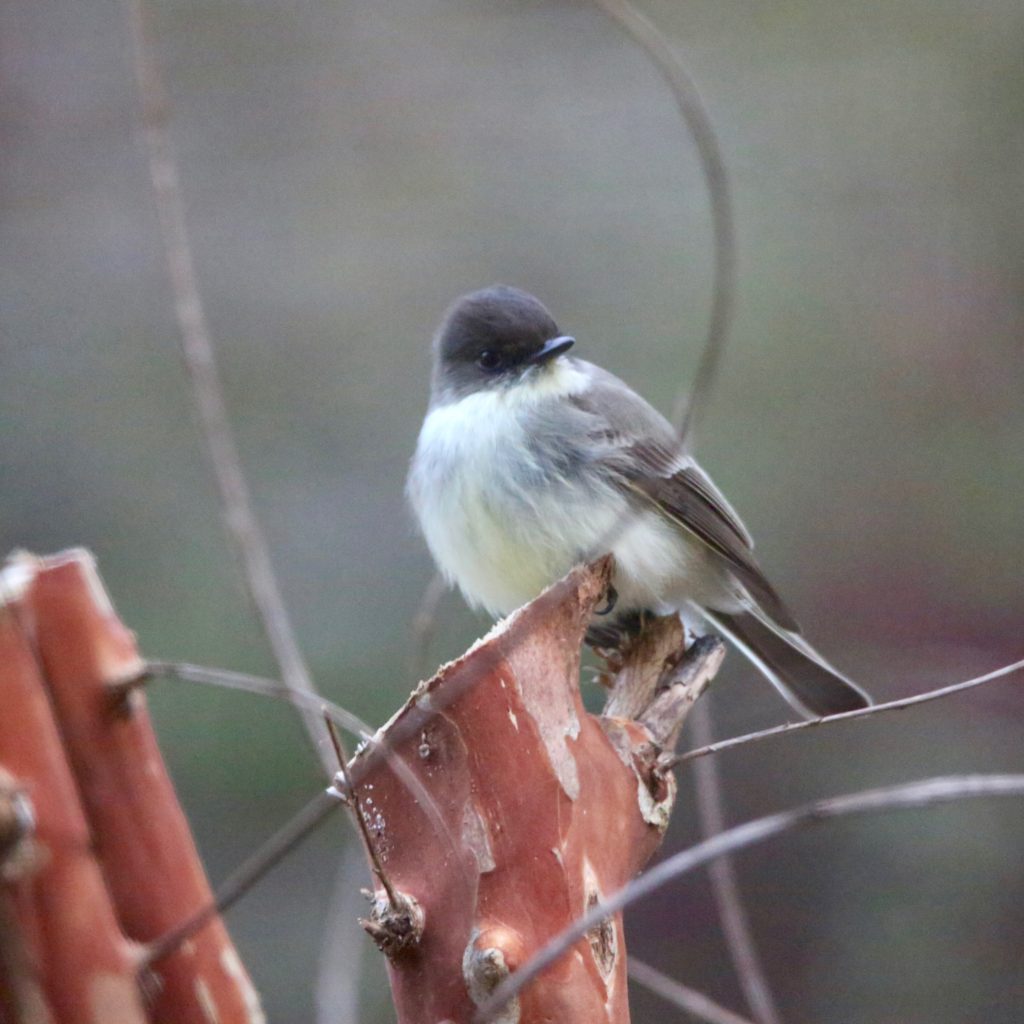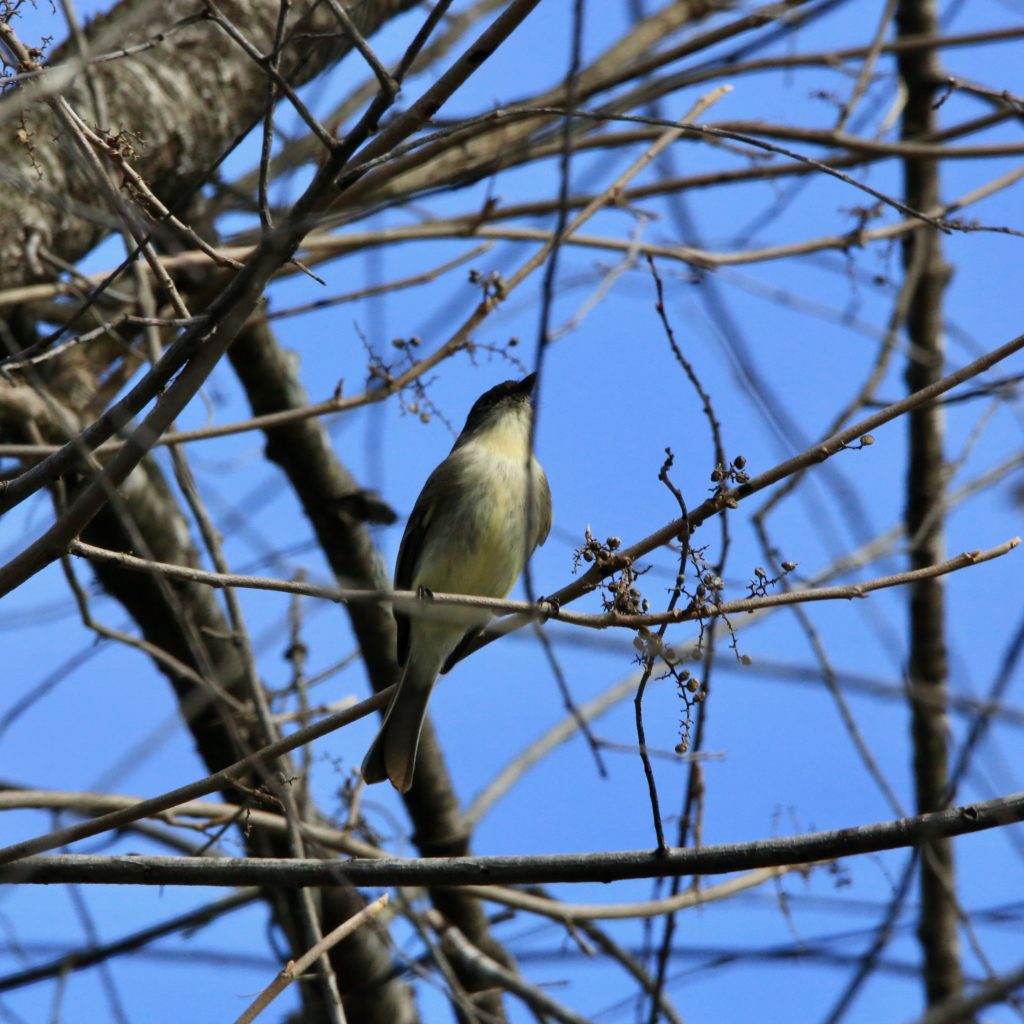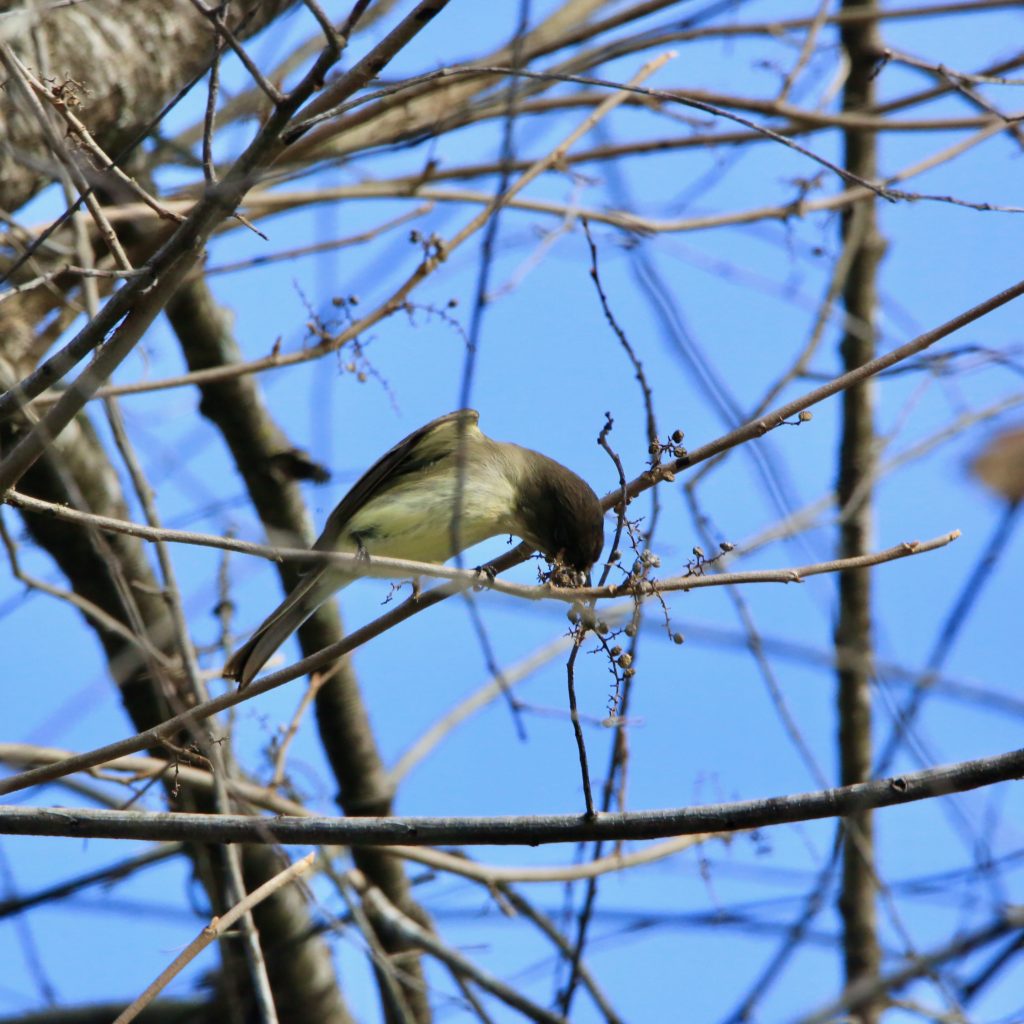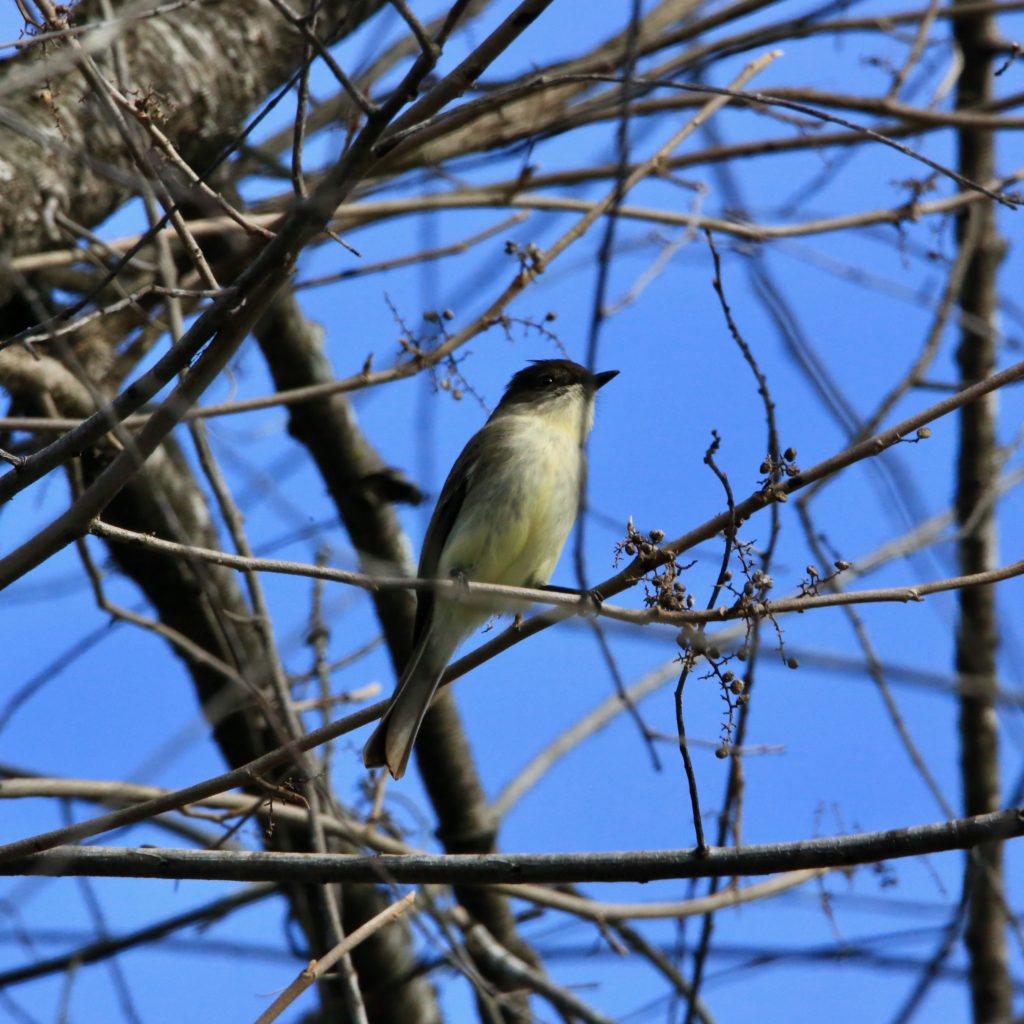
Eastern Phoebe
A Eastern Phoebe is a fun bird to see while bird watching. Below are some tips to help you identify Eastern Phoebes. We have also put together a list of fun Eastern Phoebe t-shirts, Eastern Phoebe bird patches, bird houses, bird feeders, binoculars, stickers and other fun bird watching items.
About Eastern Phoebes
It is one of the most common birds in the flycatcher species and is well known for its call which is common in yards and farms over the spring and summer periods. The Eastern Phoebe builds its nest in buildings and bridges allowing it to adapt to the changing landscape.
Description and Identification
These songbirds have plump statures with large heads and medium-length tails. They are
roughly 5.5 – 6.7 inches long with a wingspan ranging between 10.2 – 11 inches. Their
heads appear to be flat but sometimes the feathers on their crowns perch upwards into a
peak. Their bills are short and thin, ideal for catching insects. Their heads especially seem
large when they puff up their chests. The plumage is grayish-brown on the back while the
underparts are pale rust that turns white during breeding seasons. Two buff bars are also
present on each wing. It is physically unique among the flycatchers in its absence of eye
rings and pale bills, along with the presence of prominent wing bars.
Eastern Phoebe Color Pattern
Eastern Phoebes are brown with a pale gray on their upperparts and an off-white on their underside. The head is darker than most other parts of its body. Younger Eastern Phoebe shows a distinct yellow on its breast and white edges on the resting wings.
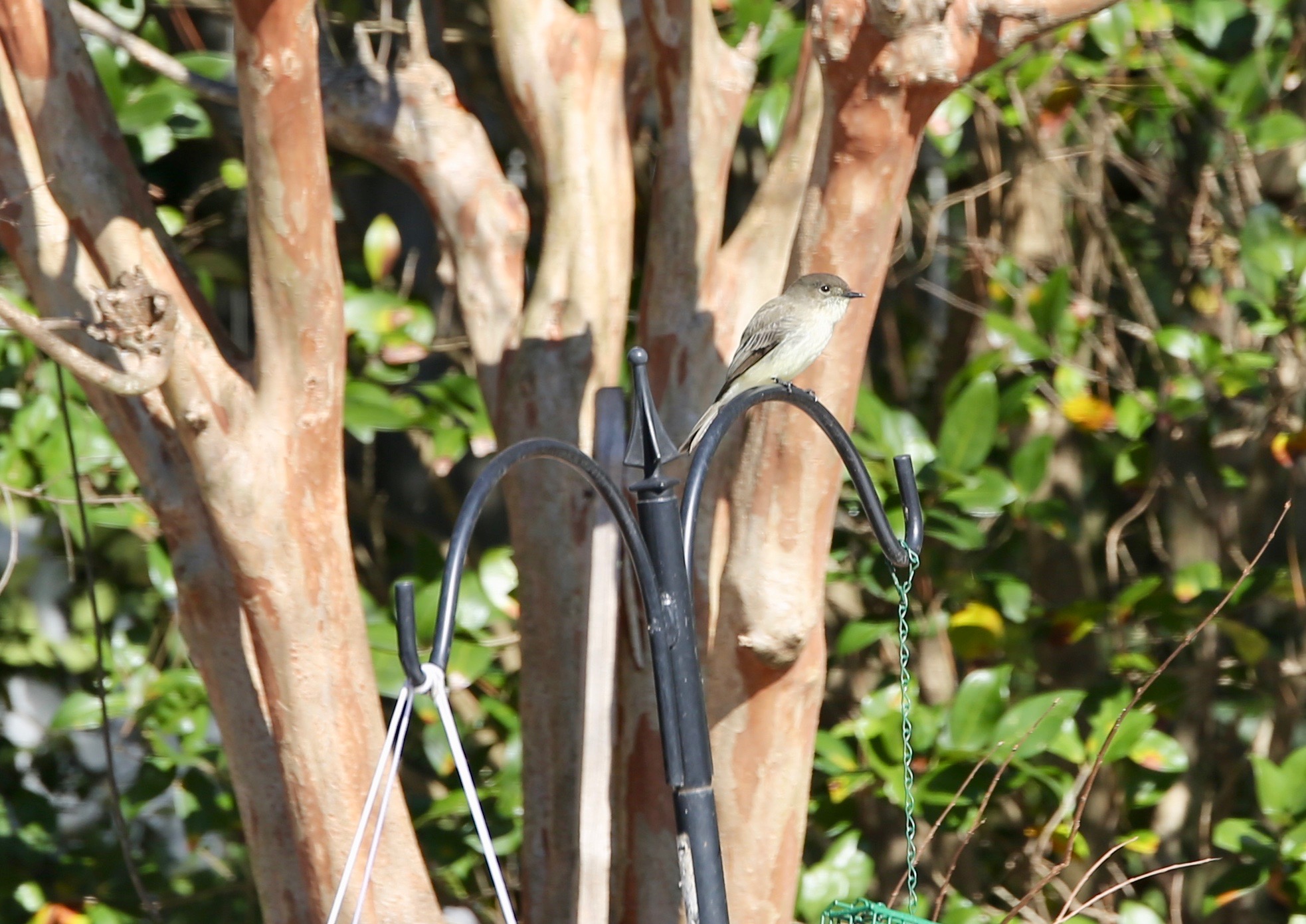
Eastern Phoebe Size
It is a fluffy and plump songbird with a medium-sized tail. Their heads may seem flat at the top but the Eastern Phoebe raises its feathers into a peak. There is no size difference between the sexes and adults have a relative size of:
- Length 14 – 17 cm
- Weight 16 – 21 g
- Wingspan 26 – 28 cm
Eastern Phoebe Behavior
Eastern Phoebes tend to perch on lo tree branches or fences. They are a hyper species making short precise flights to catch insects in flight and quickly return to the same perch. While perched they wag their tails up and down as they sing their “phoebe” song.
Eastern Phoebe Food
Like many other songbirds, Eastern Phoebes follow a diet that is mainly constituted of
insects and fruits. They consume a few fruits and seeds which are presumed to form an
important part of their diet during the winter seasons. Their main nourishment comes from a
wide range of insects during the other months, including bees, wasps, beetles, true bugs,
grasshoppers, flies, spiders, ticks, dragonflies, butterflies, moths, cicadas, and millipedes.
Insects make up most of their diet, commonly wasps, beetles, butterflies, and moths. They occasionally feed on small berries and seeds.
Eastern Phoebe Habitat
Eastern Phoebes can be found in wooded areas along steam sides and farms. They seem to
choose sites with woody understory vegetation nearby, possibly to be obscured from
potential predators and human beings. Since they require sites to be relatively close to water
sites, they can be frequently found in human settlements among structures like building
eaves, overhanging decks, bridges, and culverts. In the rural areas and the wild, they can be
found on bare rock outcrops, brushes, semi-open areas, and edges of woodlands. During
migration, their chosen sites are not necessarily close to a water source and often include
wooded areas in deciduous forests.
Eastern Phoebe breeding grounds are mostly in wooded areas near a water source. They build nests on buildings and bridges. But before they used to nest on rock outcrops with woody and short vegetation. Over the winter season, they move into deciduous woods and along woodland edges.
Range and Migration

Eastern Phoebes are small migratory passerine birds that are found all along eastern North
America. These flycatchers breed along with eastern Canada and northeastern United States
and winter along with eastern Mexico, taking land routes that are frequently viewed by
birdwatchers on the way. Many flocks of birds go all the way to Central America during the
winters, owing to a massive expansion in their population since the initiation of policies that
enforce fire suppression. They arrive for breeding relatively late during mid-March but arrive
at their wintering locations around the same time as other migrant birds, a pattern that has
been observed among Eastern Phoebes for the last 100 years.
Eastern Phoebe Lifecycle
Eastern Phoebe nests are built under overhangs to protect their young ones from predators. The female does most of the building while the male watches over her. The nest is usually from mud and leaves mixed with animal hair. She lays 2 to 6 eggs per breeding season and incubates them for 15 to 16 days. The hatchlings take an average of 20 days before they leave the nest.
Eastern Phoebe Nesting
Eastern Phoebes choose nests in dry spots typically 15 feet off the ground. They try to find
spots in niches and overhangs that offer sufficient protection from the natural elements and
keep the young out of sight from predators. In rare cases, their nests have been found
underground in wells or cisterns. The process of making the nest is carried out only by the
females, sometimes accompanied by the males. The nest is made out of mud, moss, and
leaves mixed with animal hair and grass. It requires a firm foundation to rest on and can be
found to be reused for many consecutive years during breeding. Breeding seasons generally
witness 1 – 2 broods with each clutch of eggs having 2 – 6 eggs.
Ornithology
Bird Watching Academy & Camp Subscription Boxes
At Bird Watching Academy & Camp we help kids, youth, and adults get excited and involved in bird watching. We have several monthly subscription boxes that you can subscribe to. Our monthly subscription boxes help kids, youth, and adults learn about birds, bird watching, and bird conservation.
Bird Watching Binoculars for Identifying Eastern Phoebes
The most common types of bird watching binoculars for viewing Eastern Phoebes are 8×21 binoculars and 10×42 binoculars. Bird Watching Academy & Camp sells really nice 8×21 binoculars and 10×42 binoculars. You can view and purchase them here.
Eastern Phoebe T-shirts
If you love the Eastern Phoebe you should purchase a Bird Watching Academy & Camp T-shirt. To help support bird conservation we donate 10 percent to bird conservation activities.
Eastern Phoebe Iron On Patches
Kids, Youth, and Adults love to collect our Bird Watching Academy & Camp iron on patches. Our bird watching patches help you keep track of the birds you have seen an identified. You can also display the patches on our Bird Watching Academy & Camp banners.
The Eastern Phoebe is a great iron on patch to start your collection with. The patches are durable and can be sewn on or ironed on to just about anything.
Eastern Phoebe Stickers
Stickers are a great way for you to display your love for bird watching and the Eastern Phoebe. We sell a monthly subscription sticker pack. The sticker packs have 12 bird stickers. These sticker packs will help your kids learn new birds every month.
Bird Feeders For Eastern Phoebe
There are many types of bird feeders. Here are our favorite bird feeders for your backyard. We use all of these bird feeders currently. Kids will have a great time watching birds eat at these bird feeders. Using this collection of bird feeders will provide a wide variety and many types of birds.
Best Bird Houses for Eastern Phoebe
There are many types of bird houses. Building a bird house is always fun but can be frustrating. These 4 bird houses have become our favorites. Getting a bird house for kids to watch birds grow is always fun. We spent a little extra money on these bird houses but they have been worth the higher price and look great.


